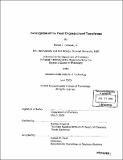| dc.contributor.advisor | Barbara Imperiali. | en_US |
| dc.contributor.author | Dempski, Robert E. (Robert Edward), 1974- | en_US |
| dc.contributor.other | Massachusetts Institute of Technology. Dept. of Chemistry. | en_US |
| dc.date.accessioned | 2006-03-24T16:10:19Z | |
| dc.date.available | 2006-03-24T16:10:19Z | |
| dc.date.copyright | 2003 | en_US |
| dc.date.issued | 2003 | en_US |
| dc.identifier.uri | http://hdl.handle.net/1721.1/29637 | |
| dc.description | Thesis (Ph. D.)--Massachusetts Institute of Technology, Dept. of Chemistry, 2003. | en_US |
| dc.description | Vita. | en_US |
| dc.description | Includes bibliographical references. | en_US |
| dc.description.abstract | Oligosaccharyl transferase catalyzes the first commited step in N-linked glycosylation. The enzyme complex from Saccharomyces cerevisiae includes nine membrane bound proteins located in the lipid bilayer of the endoplasmic reticulum, five of these proteins are essential for cell viability. The enzyme catalyzes the transfer of a tetradecasaccharide (Glc3MangGlcNAc2) cotranslationally from a dolichyl pyrophosphate donor to selected asparagine residues within the consensus sequence Asn-Xaa-Ser/Thr, where Xaa is any residue except for proline. Previous attempts to isolate the enzyme have been limited to low-yield purifications from the native species. The goal of this research was to express and purify the individual essential subunits from oligosaccharyl transferase in a heterologous expression system in order to reconstitute activity in an artificial membrane system with the long term goal of establishing the minimal catalytic complex. The four essential membrane proteins, Nlt1p, Ost2p, Swplp and Wbplp were expressed and analyzed in both the methylotropic yeast Pichia pastoris and the lytic baculovirus/insect cell expression system. The results from P. pastoris suggested that the protein was not well behaved and expressed at low levels. Expression of the native membrane proteins in baculovirus-infected insect cells proved more successful as the proteins were expressed to a high concentration and were readily solubilized using non-ionic detergents. However, these four proteins did not appear to be sufficient for catalytic activity. Purification of a Stt3p-Protein A conjugate suggests that this protein is required for catalysis. Three soluble domains of key subunits from the yeast oligosaccharyl transferase were expressed in baculovirus-infected insect cells with a partial biophysical characterization of these proteins. | en_US |
| dc.description.abstract | (cont.) The subunits have been determined to be monomeric in solution, heterogeneously glycosylated and structured. In addition, an interaction between two of these proteins sNlt1 p and sSwpl p was established using both circular dichroism and gel filtration chromatography. | en_US |
| dc.description.statementofresponsibility | by Robert E. Dempski, Jr. | en_US |
| dc.format.extent | 142 leaves | en_US |
| dc.format.extent | 5453899 bytes | |
| dc.format.extent | 5453707 bytes | |
| dc.format.mimetype | application/pdf | |
| dc.format.mimetype | application/pdf | |
| dc.language.iso | eng | en_US |
| dc.publisher | Massachusetts Institute of Technology | en_US |
| dc.rights | M.I.T. theses are protected by copyright. They may be viewed from this source for any purpose, but reproduction or distribution in any format is prohibited without written permission. See provided URL for inquiries about permission. | en_US |
| dc.rights.uri | http://dspace.mit.edu/handle/1721.1/7582 | |
| dc.subject | Chemistry. | en_US |
| dc.title | Investigation of the yeast oligosaccharyl transferase | en_US |
| dc.type | Thesis | en_US |
| dc.description.degree | Ph.D. | en_US |
| dc.contributor.department | Massachusetts Institute of Technology. Department of Chemistry | |
| dc.identifier.oclc | 53398689 | en_US |
